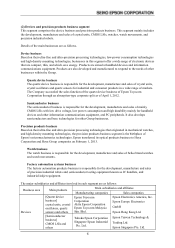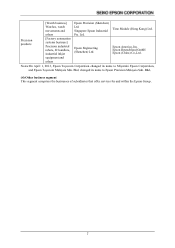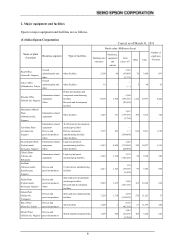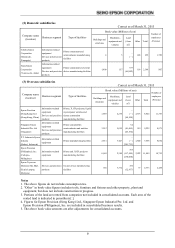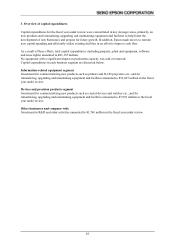Epson 2013 Annual Report Download - page 17
Download and view the complete annual report
Please find page 17 of the 2013 Epson annual report below. You can navigate through the pages in the report by either clicking on the pages listed below, or by using the keyword search tool below to find specific information within the annual report.
16
14. Epson’s intellectual property rights activities expose Epson to certain risks.
Patent rights and other intellectual property rights are extremely important to Epson for maintaining its
competitiveness. Epson has itself developed many of the technologies it needs, and it utilizes them as
intellectual property in the form of products or technologies by acquiring patent rights, trademark rights
and other intellectual property rights for them or entering into agreements with other companies for them.
Epson carefully selects the personnel who manage its intellectual properties and is constantly working to
strengthen its intellectual property portfolio.
However, if any of the following situations relating to intellectual properties occurs, Epson’s operating
results could adversely be affected.
1) An objection might be raised or an application to invalidate might be filed against an intellectual
property right of Epson and, as a result, that right might be recognized as invalid.
2) A third party to whom Epson originally had not granted a license might come to possess a license as a
result of a merger with or acquisition of another third party, and the competitive advantage that Epson
had due to that license might be lost.
3) New restrictions might be imposed on an Epson business that were not originally imposed on it as a
result of a merger with or acquisition of a third party, and it might be forced to spend money to find a
solution to those restrictions.
4) Intellectual property rights that Epson holds might not give it a competitive advantage or Epson might
not be able to use them effectively.
5) Epson or one of its customers might be subject to a third-party’s claim of an infringement of
intellectual property rights and have to spend a considerable amount of time and money to resolve the
issue, or such a claim might interfere with Epson’s ability to focus its managerial resources.
6) If a third-party’s claim of infringement of intellectual property right is upheld, Epson might incur
damage in the form of having to pay considerable compensation or royalties or stop using the
applicable technology.
7) A suit might be brought against Epson for payment of remuneration to employees or the like for their
inventions or the like, which would mean Epson might be forced to spend a considerable amount of
time and money to resolve the issue and, as a result, might be required to pay a considerable amount
of money in remuneration.
15. Problems may arise relating to the quality of Epson’s products.
The existence of quality guarantees on Epson’s products and the details of those guarantees differ from
customer to customer, depending on the agreement it has entered into with them. If an Epson product is
defective or does not conform to the required standard, it may have to be replaced or repaired or otherwise
reworked at Epson's expense. Or, if the product causes personal injury or property damage, Epson could
bear product liability or hold other liability.
Also, Epson could be held liable to a customer and could incur expenses for repairs or corrections on the
grounds that it did not adequately explain an Epson product’s features or performance. Furthermore, if such
a problem in quality arises with respect to Epson products, Epson might lose the trust of others in its
products, lose major customers or experience a drop in demand for those products, any of which might
adversely affect Epson’s operating results.
16. Epson is vulnerable to risks of problems arising relating to the environment.
Epson is subject, both in Japan and overseas, to various environmental regulations concerning industrial
waste and emissions into the atmosphere that arise from manufacturing processes. Environmental
conservation is one of Epson’s most important management policies, and the Company is proactively
engaged in environmental conservation on all fronts. For example, Epson has programs to develop and
manufacture products that have a smaller environmental burden, reduce energy use, promote the recovery
and recycling of end-of-life products, and improve environmental management systems. To date, Epson has
not had any serious environmental issue, but there is a possibility that in the future Epson might be affected
by a compensation claim, incur expenses (such as cleaning expenses), receive a fine, be ordered to cease
production or be otherwise affected as a result of environmental damage or that new regulations might be
brought in requiring Epson to pay considerable expenses, and, if such a situation should occur, Epson’s
operating results could adversely be affected.


